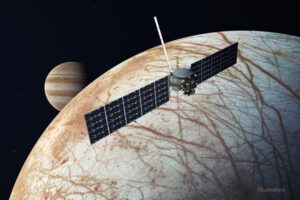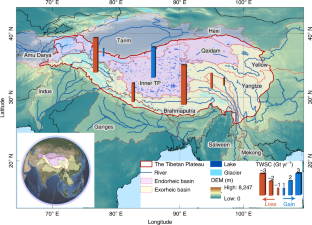2022-08-15 テキサス大学オースチン校(UT Austin)

An illustration of NASA’s Europa Clipper spacecraft flying by Jupiter’s moon Europa. The spacecraft, which is planned to launch in 2024, will carry an ice-penetrating radar instrument developed by scientists at the University of Texas Institute for Geophysics. Credit: NASA/JPL-Caltech.
NASAの探査機「エウロパ・クリッパー」は、レーダーを使って氷の殻の下をのぞき、エウロパの海が生命にとって快適な場所かどうかを調べる。氷の中に閉じ込められた塩分は、レーダーが氷の殻をどの程度深く見ることができるかに影響するので、氷が何でできているかを予測することができれば、科学者がデータの意味を理解するのに役立つからです。
今回の研究では、棚氷の下で水が凍る2つの異なる方法、コンジェレーションアイスとフラジルアイスを調べた。棚氷は、棚板の下から直接成長する。フラジール氷は、過冷却された海水中の氷片が水中を上昇し、棚氷の底に沈むことで形成される。
どちらの方法でも、海水よりも塩分の少ない氷ができる。ウォルフェンバーガーは、エウロパの氷の殻の大きさと年齢まで拡大すると、塩分がさらに少なくなることを発見したのだ。さらに、彼女の計算によると、海水中の塩分のごく一部を残すフラジルアイスは、エウロパに非常に多く存在する可能性がある。
<関連情報>
- https://news.utexas.edu/2022/08/15/underwater-snow-gives-clues-about-europas-icy-shell/
- https://www.liebertpub.com/doi/abs/10.1089/ast.2021.0044?journalCode=ast
海洋世界の氷殻構造と組成:地球上の堆積氷からの洞察. Ice Shell Structure and Composition of Ocean Worlds: Insights from Accreted Ice on Earth
Natalie S. Wolfenbarger,Jacob J. Buffo,Krista M. Soderlund and Donald D. Blankenship
Astrobiology Published:25 Jul 2022
DOI:https://doi.org/10.1089/ast.2021.0044
Abstract
Accreted ice retains and preserves traces of the ocean from which it formed. In this work, we study two classes of accreted ice found on Earth—frazil ice, which forms through crystallization within a supercooled water column, and congelation ice, which forms through directional freezing at an existing interface—and discuss where each might be found in the ice shells of ocean worlds. We focus our study on terrestrial ice formed in low temperature gradient environments (e.g., beneath ice shelves), consistent with conditions expected at the ice-ocean interfaces of Europa and Enceladus, and we highlight the juxtaposition of compositional trends in relation to ice formed in higher temperature gradient environments (e.g., at the ocean surface). Observations from Antarctic sub-ice-shelf congelation ice and marine ice show that the purity of frazil ice can be nearly two orders of magnitude higher than congelation ice formed in the same low temperature gradient environment (∼0.1% vs. ∼10% of the ocean salinity). In addition, where congelation ice can maintain a planar ice-water interface on a microstructural scale, the efficiency of salt rejection is enhanced (∼1% of the ocean salinity) and lattice soluble impurities such as chloride are preferentially incorporated. We conclude that an ice shell that forms by gradual thickening as its interior cools would be composed of congelation ice, whereas frazil ice will accumulate where the ice shell thins on local (rifts and basal fractures) or regional (latitudinal gradients) scales through the operation of an “ice pump.”



